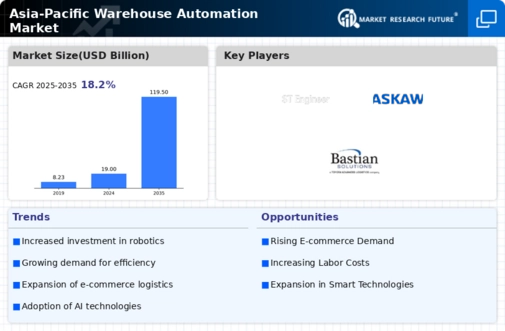Labor Shortages
Labor shortages in the Asia-Pacific region are increasingly influencing the Global Asia-Pacific Warehouse Automation Market Industry. With a declining workforce and rising labor costs, companies are turning to automation as a viable solution to maintain productivity levels. Automated systems, such as robotic picking and sorting technologies, can mitigate the impact of labor shortages by enhancing operational efficiency. This trend is likely to accelerate as businesses seek to optimize their workforce and reduce dependency on manual labor. The shift towards automation is expected to contribute to the market's growth, with projections indicating a market size of 85 USD Billion by 2035.
Government Initiatives
Government initiatives aimed at promoting automation and technological adoption are significantly impacting the Global Asia-Pacific Warehouse Automation Market Industry. Various governments in the region are implementing policies and providing incentives to encourage businesses to invest in automation technologies. These initiatives are designed to enhance productivity, improve supply chain resilience, and foster economic growth. As a result, companies are more inclined to integrate automated solutions into their operations. The supportive regulatory environment is expected to facilitate market expansion, contributing to the projected growth of the industry as businesses seek to leverage government support for automation investments.
Sustainability Concerns
Sustainability concerns are increasingly influencing the Global Asia-Pacific Warehouse Automation Market Industry. As environmental awareness grows, companies are seeking ways to reduce their carbon footprint and enhance operational sustainability. Automated systems can contribute to these goals by optimizing resource utilization, minimizing waste, and improving energy efficiency. For instance, automated guided vehicles can reduce energy consumption compared to traditional methods. This focus on sustainability is likely to drive investments in automation technologies, as businesses strive to align their operations with environmental standards and consumer expectations. The growing emphasis on sustainability may further accelerate market growth in the coming years.
Rising E-commerce Demand
The surge in e-commerce activities across the Asia-Pacific region is a primary driver for the Global Asia-Pacific Warehouse Automation Market Industry. As online shopping continues to gain traction, businesses are compelled to enhance their logistics and supply chain operations. This shift necessitates the adoption of automated systems to manage increasing order volumes efficiently. In 2024, the market is projected to reach 35 USD Billion, reflecting the growing need for advanced warehousing solutions that can accommodate rapid order fulfillment and inventory management. Companies are investing in automation technologies to streamline operations and improve customer satisfaction.
Technological Advancements
Technological advancements play a crucial role in shaping the Global Asia-Pacific Warehouse Automation Market Industry. Innovations in robotics, artificial intelligence, and the Internet of Things are driving the development of sophisticated automation solutions. These technologies enable warehouses to operate with greater precision and efficiency, reducing operational costs and improving service levels. As companies increasingly adopt these advanced systems, the market is anticipated to witness a compound annual growth rate of 8.4% from 2025 to 2035. This growth trajectory underscores the importance of staying abreast of technological trends to remain competitive in the evolving logistics landscape.













Leave a Comment